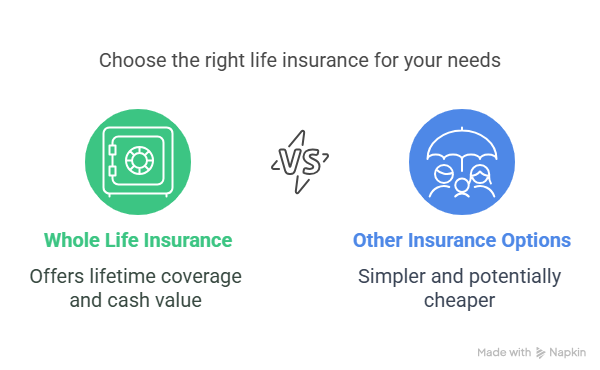Considering whole life insurance can be a significant financial decision. It’s essential to understand the advantages and disadvantages before making a choice.
Understanding the intricacies of whole life insurance is vital. It offers a death benefit and a savings component, but it can be more complex and costly than other insurance types.
Key Takeaways
- Whole life insurance provides lifetime coverage and a cash value component.
- It’s more complex and potentially costly than other insurance options.
- Understanding the pros and cons is crucial for making an informed decision.
- Financial goals and needs should be considered when evaluating whole life insurance.
- The cash value component grows over time, offering a savings element.

What Is Whole Life Insurance?
Whole life insurance is a comprehensive financial tool that offers both a death benefit and a savings component. It is designed to provide lifetime coverage, as long as premiums are paid, and includes a cash value accumulation feature.
How Whole Life Insurance Works
Whole life insurance works by combining a death benefit with a savings component. A portion of the premiums paid is allocated to the cash value, which grows over time. This cash value can be borrowed against or used to pay premiums. The insurance remains in effect for the insured’s lifetime, provided premiums are paid as required.
Whole Life vs. Term Life Insurance
The primary difference between whole life and term life insurance lies in their coverage periods and additional features. Term life insurance covers you for a specified term, whereas whole life insurance covers you for your entire life. Additionally, whole life insurance includes a cash value component that term life insurance does not have.
| Feature | Whole Life Insurance | Term Life Insurance |
|---|---|---|
| Coverage Period | Lifetime | Specified Term |
| Cash Value Component | Yes | No |
| Premiums | Fixed | Varies by Term |
The Advantages of Whole Life Insurance
One of the most significant advantages of whole life insurance is its comprehensive coverage. This type of insurance provides a range of benefits that make it an attractive option for individuals seeking long-term financial security.
Lifetime Coverage
Whole life insurance offers lifetime coverage as long as premiums are paid. This means that your beneficiaries will receive a death benefit regardless of when you pass away, providing peace of mind and financial protection.
Cash Value Accumulation
Another significant benefit is the cash value accumulation feature. Over time, a portion of your premiums accumulates as cash value, which you can borrow against or use to pay premiums.
Fixed Premiums
Whole life insurance policies typically come with fixed premiums, making it easier to budget for your insurance costs. Your premiums will remain the same throughout the life of the policy.
Tax Benefits
Whole life insurance also offers tax benefits. The cash value grows tax-deferred, and the death benefit is generally income tax-free to beneficiaries.
| Feature | Benefit | Advantage |
|---|---|---|
| Lifetime Coverage | Provides financial protection for beneficiaries | Peace of mind and financial security |
| Cash Value Accumulation | Accumulates cash value over time | Can be used to pay premiums or borrowed against |
| Fixed Premiums | Premiums remain the same throughout the policy | Easier to budget for insurance costs |
| Tax Benefits | Cash value grows tax-deferred | Reduces tax liability for beneficiaries |
Whole Life Insurance Pros and Cons: Key Drawbacks
Despite its benefits, whole life insurance has several key drawbacks that need to be examined closely. While it offers lifetime coverage and a cash value component, there are significant disadvantages to consider.
Higher Premium Costs
One of the main drawbacks is the higher premium costs associated with whole life insurance compared to term life insurance. Premiums are typically fixed and higher because they not only cover the cost of insurance but also contribute to the cash value component.
Lower Initial Death Benefit
Another consideration is that the initial death benefit may be lower than that of term life insurance for the same premium amount. This is because a portion of the premium is allocated towards the cash value accumulation.
Complex Policy Features
Whole life insurance policies can be complex, with various features and riders that may be difficult to understand. It’s crucial to thoroughly review the policy terms to grasp what is included.
Limited Investment Returns
The cash value component of whole life insurance typically grows at a fixed rate or based on the performance of a specific investment portfolio. Returns may be limited compared to other investment options, which is an important consideration for those looking to maximize their investment.
Understanding these drawbacks is essential to making an informed decision about whether whole life insurance is the right choice for your financial situation and goals.
Conclusion: Is Whole Life Insurance Right for You?
When considering whole life insurance, understanding its upsides and downsides is crucial. On one hand, whole life insurance provides lifetime coverage, a cash value component, and fixed premiums, making it an attractive option for those seeking a long-term investment and insurance coverage.
On the other hand, the higher premium costs, lower initial death benefit, and complex policy features are significant drawbacks to consider. Weighing these whole life insurance upsides and downsides will help you make an informed decision about whether this type of insurance aligns with your financial goals and needs.
Ultimately, whole life insurance can be a valuable addition to your financial portfolio if you’re looking for a stable, long-term investment and are willing to commit to the higher premiums. Carefully evaluating your options and considering your individual circumstances will help you determine if whole life insurance is the right choice for you.
FAQ
What are the primary benefits of whole life insurance?
The primary benefits of whole life insurance include lifetime coverage, cash value accumulation, fixed premiums, and tax benefits, providing a comprehensive financial protection plan.
How does whole life insurance differ from term life insurance?
Whole life insurance provides coverage for your entire lifetime, whereas term life insurance covers you for a specified period. Whole life insurance also accumulates a cash value over time, which is not a feature of term life insurance.
What are the drawbacks of whole life insurance?
The drawbacks of whole life insurance include higher premium costs, lower initial death benefit, complex policy features, and limited investment returns, making it essential to weigh these against the benefits.
Can I borrow against my whole life insurance policy?
Yes, you can borrow against the cash value of your whole life insurance policy, providing a source of funds in times of need, but be aware that outstanding loans can reduce the policy’s death benefit.
Are whole life insurance dividends taxable?
Generally, whole life insurance dividends are not taxable, but it’s crucial to consult with a tax professional to understand the specific tax implications of your policy.
How do I determine if whole life insurance is right for me?
To determine if whole life insurance is right for you, consider your financial goals, budget, and insurance needs, and consult with a licensed insurance professional to find the best policy for your situation.
What are the whole life insurance advantages and disadvantages I should consider?
When evaluating whole life insurance, consider its advantages, such as lifetime coverage and cash value accumulation, against its disadvantages, including higher premiums and complex features, to make an informed decision.
Can whole life insurance be used as a retirement savings tool?
Yes, whole life insurance can be used as a retirement savings tool, as the cash value accumulated over time can supplement your retirement income, but it’s essential to understand the policy’s terms and conditions.
How do I choose the best whole life insurance policy?
To choose the best whole life insurance policy, compare different insurance providers, consider your financial situation and goals, and consult with a licensed insurance professional to find a policy that meets your needs.



